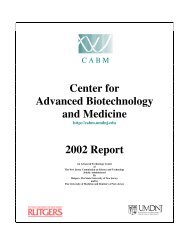Annual Report 2011 - Center for Advanced Biotechnology and ...
Annual Report 2011 - Center for Advanced Biotechnology and ...
Annual Report 2011 - Center for Advanced Biotechnology and ...
Create successful ePaper yourself
Turn your PDF publications into a flip-book with our unique Google optimized e-Paper software.
properties by lowering susceptibility to proteolysis. Typically, such modifications are<br />
introduced in lead compounds by trial-<strong>and</strong>-error or combinatorial approaches.<br />
Our laboratory is developing components in protCAD to simulate the impact of nonnatural<br />
amino acids on structure <strong>and</strong> stability. Using fundamental principles of protein<br />
design, we will pursue the computational, structure-based development of peptides<br />
with variable chirality, broadly extending our capacity to create safe <strong>and</strong> potent<br />
therapeutics.<br />
Biochemical Basis of Food Allergies<br />
A crucial <strong>and</strong> unanswered question in the field of food allergy research is why certain<br />
proteins elicit an IgE mediated immune response, while others are tolerated. One<br />
compelling model is that non-allergens are more digestible, resulting in sufficient<br />
protein degradation in the stomach <strong>and</strong> intestine to render the remaining fragments<br />
immunologically inert. In this project, we develop a highly defined system <strong>for</strong><br />
exploring the relationship between digestibility <strong>and</strong> allergenicity using engineered<br />
variants of protein allergens from peanut <strong>and</strong> shrimp.<br />
Natural collagens in the connective<br />
tissue or the basement membrane<br />
assemble in a hierarchic fashion.<br />
Our peptides proceed from<br />
monomer to trimer to fiber, <strong>and</strong><br />
finally to a hydrogel. Hydrogels are<br />
versatile materials with applications<br />
in drug delivery, tissue scaffolds<br />
<strong>and</strong> enzyme immobilization. Insight<br />
gained from this study will improve<br />
molecular design of biomimetic<br />
materials. TOP PICTURE: Phase<br />
diagram of peptides CPB <strong>and</strong> CPC<br />
combinations showing the diversity<br />
of self-assembling structures<br />
<strong>for</strong>med. BOTTOM PICTURE:<br />
Electron Microscopy images of<br />
negatively stained CPB:CPC<br />
samples at various mixing ratios.<br />
Mihir Joshi<br />
Research Assistant<br />
Kenneth<br />
McGuinness<br />
Research Asstistant<br />
Yol<strong>and</strong>a Hom<br />
Technician<br />
63



